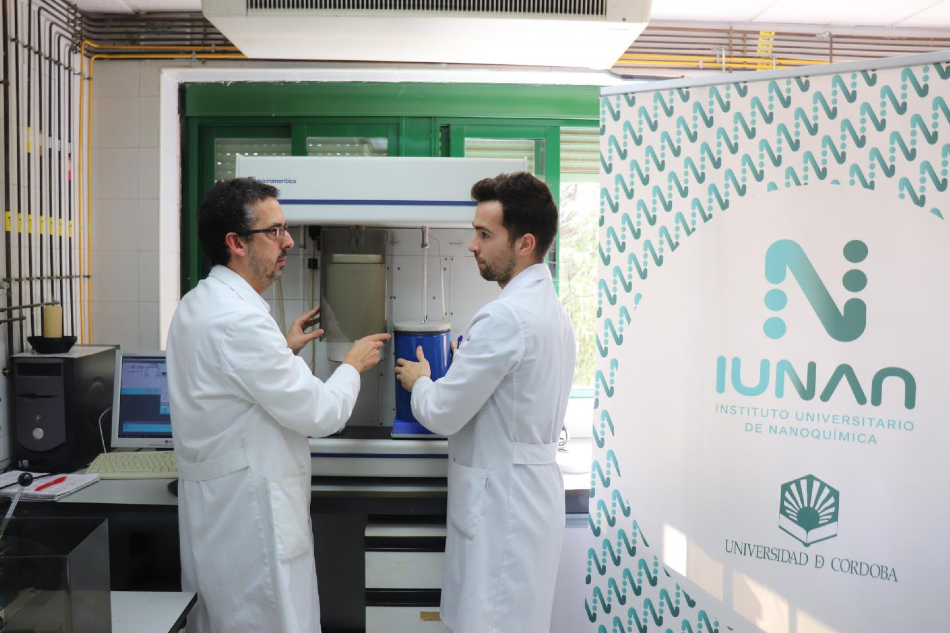Mar 4 2020
Despite their competition with batteries based on magnesium and sodium over the past few years, Lithium-ion batteries have been used across the globe, and they remain essential due to their high capacity and density.
 Álvaro Caballero (left.) and Fernando Luna, working in the laboratory. Image Credit: University of Córdoba.
Álvaro Caballero (left.) and Fernando Luna, working in the laboratory. Image Credit: University of Córdoba.
The problem is that lithium has critical concentration and availability issues. Nearly 85% of the reserves of the metal are situated in the so-called Lithium Triangle, a geographical area bordering Chile, Argentina, and Bolivia.
Moreover, it is assumed that the demand for lithium will increase exponentially in the next few decades due to the implementation of electric vehicles. A single car battery is equivalent to around 7,000 cell phone batteries. Thus, reusing their various components has become a matter of ultimate importance.
Particularly, a project based on research was conducted at the University of Cordoba (Spain) and San Luis University (Argentina), which involved Lucía Barbosa, Fernando Luna, Yarivith González Peña, and Álvaro Caballero.
The researchers could develop new lithium batteries from used cell phones, which are devices that have a low recycling rate and could get added to the never-ending list of electronic waste generated worldwide annually if not handled properly.
The scientists involved in this project identified a specific method to recycle the graphite in these devices, a material found in the negative terminals of batteries and serves to store and conduct lithium.
Professor Álvaro Caballero, one of the lead authors of the study, pointed out that the scientists could remove the impurities of used graphite, rearrange its structure, and reactivate it for fresh use.
An intriguing fact is that graphite constitutes a quarter of the total weight of a lithium battery. Thus, upon recycling, “we are recovering 25% of the whole energy storage system, a fact that is all the more relevant considering that this material comes from crude oil,” stated Caballero.
In this study, another essential aspect was the feasibility of eliminating the use of cobalt on the positive terminal of the new recycled battery, which is extensively used in the mobile device sector.
Cobalt is a toxic element that is more expensive than others like manganese and nickel, which were used in this research.
Fernando Luna, Study Lead Author and Researcher, University of Córdoba
Moreover, it is one of the known blood minerals, whose mining, such as coltan mining, is linked to mines in conflict zones.
Promising Results
As per the findings of the study, “the results are comparable and in some cases better than those obtained from commercial graphite.” A few tests revealed that in best-case scenarios, the capacity of the battery is maintained even after a hundred charge cycles, which is equivalent to the performance of nearly a year.
Although the results are promising and the tests were performed on complete cells of a real battery, the study was carried out in the lab on a small level. Therefore, there is still a long path to tread until this manual process of recycling can be standardized.
Currently, more than 90% of lead battery components used in conventional vehicles are reused. If we opt for sustainability and the democratization of electric cars, large-scale recycling of lithium batteries has to come about.
Álvaro Caballero, Researcher, Department of Inorganic Chemistry and Chemical Engineering, University of Córdoba
The study, which involved the FQM 175 research team from the School of Science at the University of Cordoba and the University Institute of Nanochemistry (abbreviated to IUNAN in Spanish) participated, was funded by the Ministry of Science, Innovation, and Universities within the framework of the project titled “Advances in lithium-sulfur battery technology: safety, sustainability, and Performance.”